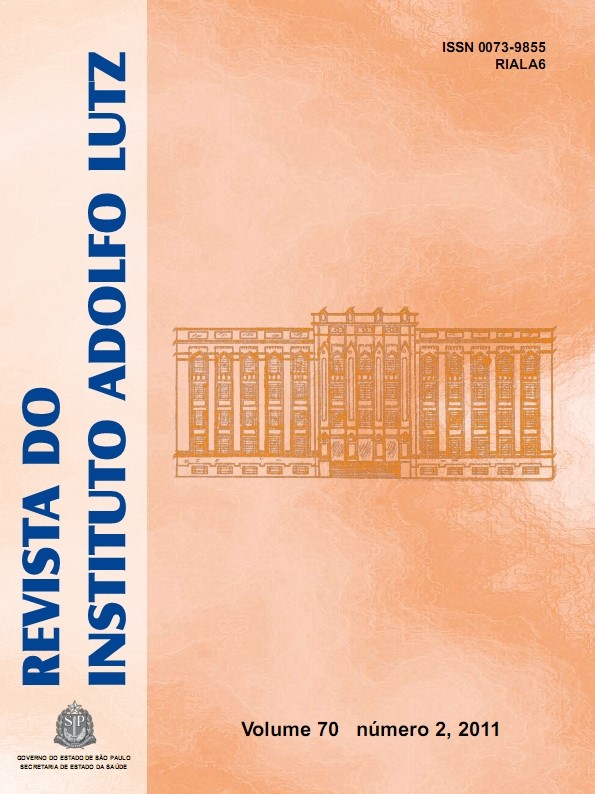Resumo
A criopreservação de vírus da raiva tem sido descrita de forma sucinta na literatura científica. Até o presente, poucas informações encontram-se disponíveis sobre o uso de agentes crioprotetores na conservação a frio de vírus da raiva. O objetivo deste trabalho foi de analisar a viabilidade de vírus da raiva expostos aos procedimentos de congelação/descongelação e de avaliar o efeito do dimetilsulfóxido (DMSO), do glicerol (GLI), do polietilenoglicol (PEG) e da sacarose (SAC), em diferentes concentrações, na criopreservação de vírus da raiva. A viabilidade viral foi testada por meio de isolamento viral utilizando-se testes de inoculação em camundongos, titulação viral e imunofluorescência direta antes e 30 dias após terem sido instituídos os protocolos de congelação. A viabilidade das amostras de vírus da raiva após criopreservação na ausência de agentes crioprotetores foi inferior àquela observada em outros tratamentos. Após 30 dias de congelação, a viabilidade das amostras criopreservadas com adição de DMSO, GLI e PEG foi mais baixa do que a observada em amostras frescas. Adicionalmente, o uso da sacarose nas concentrações de 10% ou 68% induziu efeitos positivos na viabilidade das partículas virais após criopreservação a curto prazo.
Referências
1. Day JG, McLellan MR. Cryopreservation and freeze-drying protocols. New Jersey: Humana Press; 1995.
2. Paoli DP. Biobanking in microbiology: from sample collection to epidemiology, diagnosis and research. FEMS Microbiol Rev. 2005;29:897-910.
3. Hubálek Z. Protectants used in the cryopreservation of microorganisms. Cryobiol. 2003;46:205-29.
4. Gould EA. Virus cryopreservation and storage. In: Day JG, McLellan MR. Cryopreservation and freeze-drying protocols. New Jersey: Humana Press; 1995.
5. Paynter SJ. Principles and practical issues for cryopreservation of nerve cells. Brain Res Bull. 2008;75:1-14.
6. Howell CL, Miller MJ. Effect of sucrose phosphate and sorbitol on infectivity of enveloped viruses during storage. J Clin Microbiol. 1983;3:658-62.
7. Koprowski H. The mouse inoculation test. In: Meslin FX, Kaplan MM, Koprowski H. (Eds). Laboratory Techniques in Rabies, 4th ed. Geneva: World Health Organization; 1996. p.80-86.
8. Reed LJ, Müench H. A simple method of estimating fifty per cent endpoints. Am J Hyg. 1938;27:493-7.
9. Dean DJ, Abelset MK, Atanasiu P. The fluorescent antibody test. In: Meslin FX, Kaplan MM, Koprowski H. (Eds). Laboratory Techniques in Rabies, 4th ed. Geneva: World Health Organization; 1996. p.88-95.
10. Bingham J, Merwe M. Distribution of rabies antigen in infected brain material: determining the reliability of different regions of the brain for the rabies fluorescent antibody text. J Virol Methods. 2002;101:85-94.
11. Schnell MJ, McGettigan JP, Wirblich C, Papaneri A. The cell biology of rabies virus: using stealth to reach the brain. Nat Rev Microbiol. 2010;8:51-61.
12. Wacharapluesadee S, Ruangvejvorachai P, Hemachuda T. A simple method for detection of rabies viral sequences in 16-year old archival brain specimens with one-week fixation in formalin. J Virol Methods. 2006;134:267-71.
13. Lopes MC, Venditti LLR, Queiroz LH. Comparison between RT-PCR and the mouse inoculation test for detection of rabies virus in samples kept for long periods under different conditions. J Virol Methods. 2010;164:19-23.
14. Fabbri R, Porcu E, Marsella T, Rocchetta G, Venturoli S, Flamigni C. Human oocyte cryopreservation: new perspectives regarding oocyte survival. Hum Reprod. 2001;16:411-6.
15. Chen ZJ, Li M, Li Y, Zhao LX, Tang R, Sheng Y, Gao X, Chang CH, Feng HL. Effects of sucrose concentration on the developmental potential of human frozen-thawed oocytes at different stages of maturity. Hum Reprod. 2004;10:2345-9.

Este trabalho está licenciado sob uma licença Creative Commons Attribution 4.0 International License.
Copyright (c) 2011 Edmara Chaves Costa, Maria Fátima da Silva Teixeira, Tereza D'Ávila de Freitas Aguiar, Benedito Neilson Rolim, Phyllis Catharina Romijn, Marcos Fábio Gadelha Rocha
